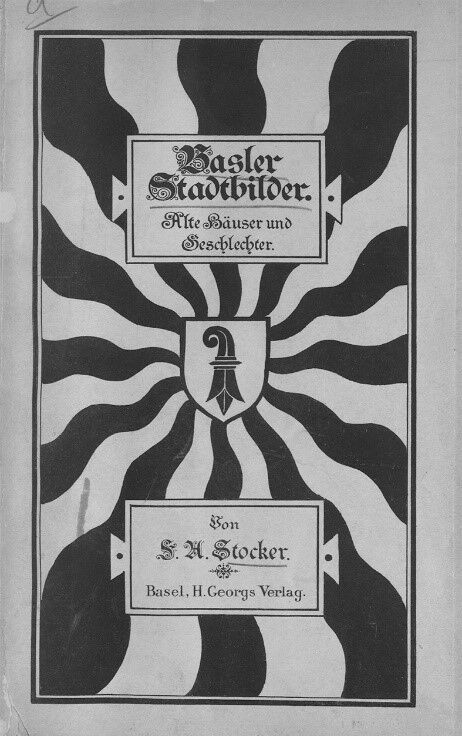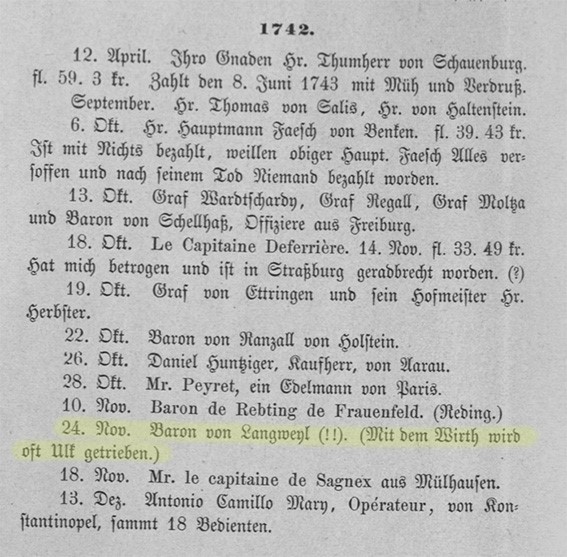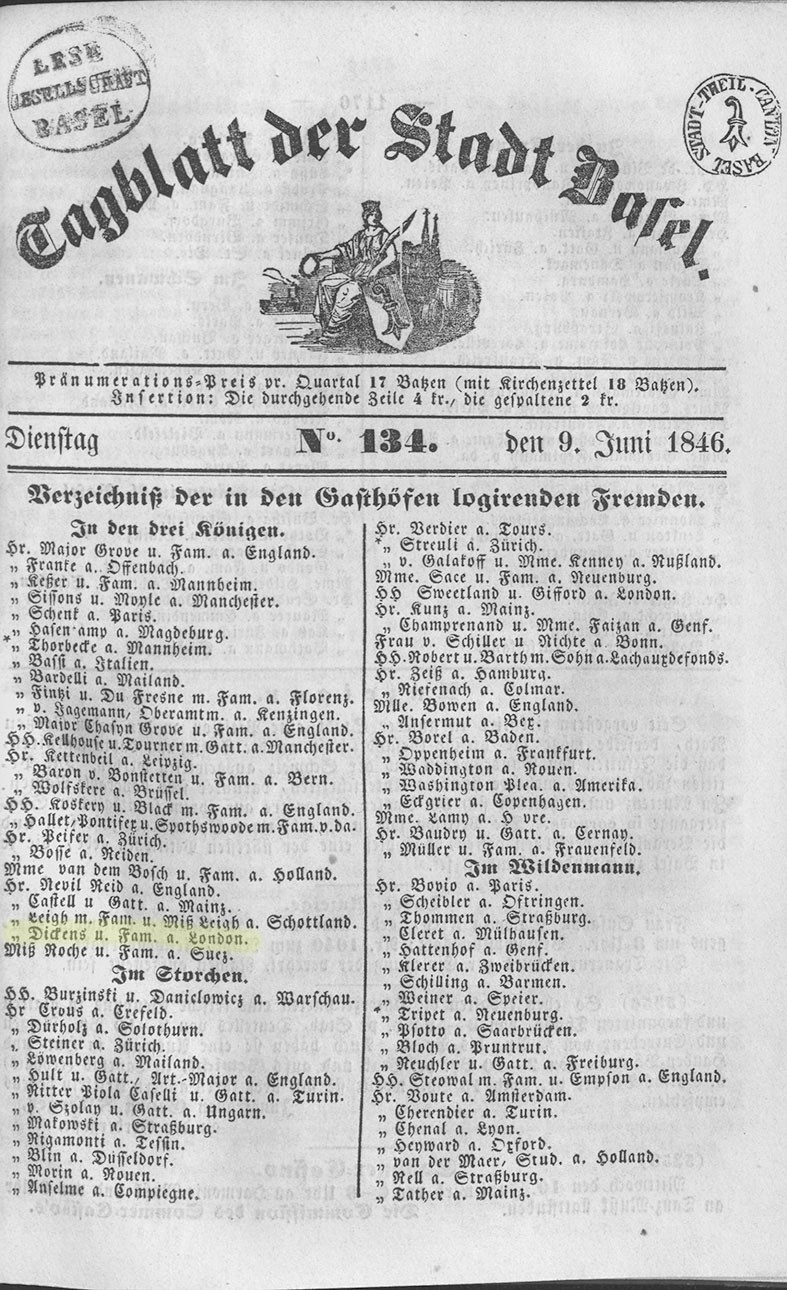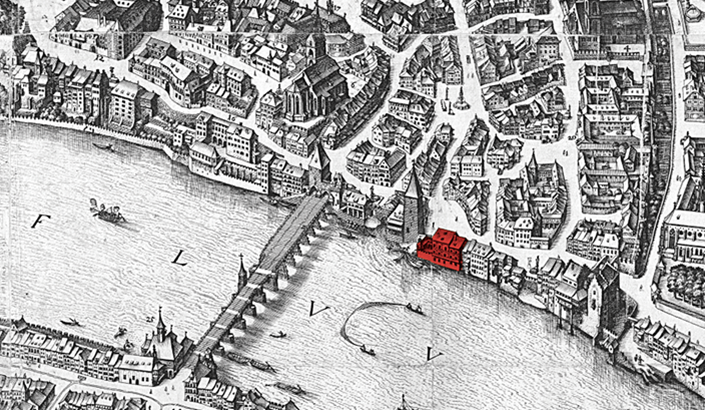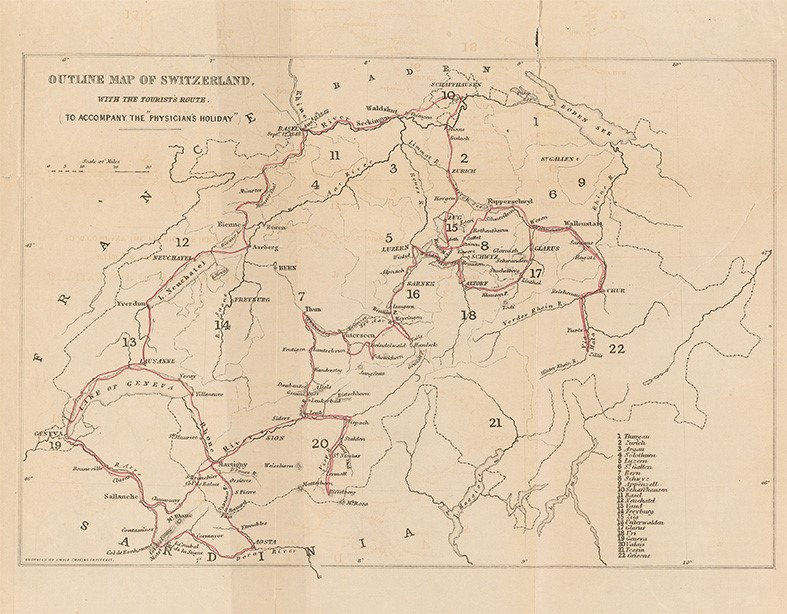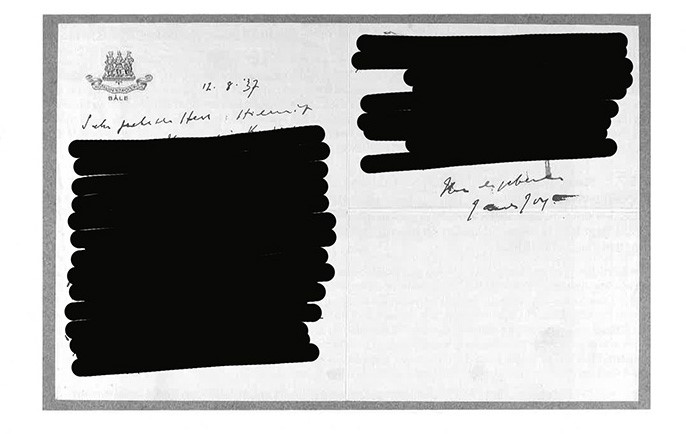Illustrious British and Irish Visitors at the Grand Hotel 'Les Trois Rois' in Basel
Daniela Keller, University of Basel

© Grand Hotel Les Trois Rois
Basel’s most luxurious and historic Grand Hotel Les Trois Rois, which was first opened in 1681, attracted a large amount of guests from the British Isles on their Grand Tours, especially during the 18th and 19th century, seeking cultural education, recreation or an adventure in the Swiss Alps (see also Triet et al. 135-36). It was the beginning of mass tourism; travel agencies such as Thomas Cook were founded; and Switzerland’s tourism industry profited from its prominent British guest Queen Victoria. Her influence remains visible today as many hotels throughout Switzerland still carry her name (swissinfo). As far as we know, however, Queen Victoria did not spend time at the Grand Hotel Les Trois Rois, unlike her mother, Duchess Victoria of Kent (1786-1861), in May 1844 (Triet et al. 132; Nagel).
While compiling a list of British and Irish guests, we have been able to rely on the thorough research done by Maximilian Triet and his co-authors who published an extensive portrait of the hotel and its history in 2006 (see Les Trois Rois: Einblicke in die Geschichte). They highlight the challenges we also faced in finding illustrious visitors, as the hotel does not hold an archive nor exhaustive guest lists; information on visitors is scattered and not easily accessible because proof of people’s presence is often (if at all) documented in unpublished private letters and diaries (9, 65).
There are only very few sources that provide an official list of guests:
1. 18th century: The landlord’s diary
Johann Christoph Im Hof was the hotel’s owner and landlord from 1739 to 1765 and kept a so-called Wirtsbuch from August 1739 to July 1744. Unfortunately, the original diary is lost, but luckily a transcript survives in Franz August Stocker’s documentation Basler Stadtbilder: Alte Häuser und Geschlechter (1890).
Im Hof would not only note down what his guests consumed, but would add their manner of paying, whether it was done generously, hesitantly, or not at all (Triet et al. 49; Stocker 116-128). His diary is a treasure chest of names with entries, such as “Mr Salis, Envoyé d’Engleterre” (guest in 1743; Stocker 124) or “Baron von Langweyl” (baron of boredom; guest in 1742; Stocker 122) with a comment from Im Hof, showing that he is well aware that this is a ridiculous pseudonym (see excerpt of Wirtsbuch).
The Sottish writer James Boswell (1740-1795), who kept a journal while visiting the Continent, stayed at the Les Trois Rois for two nights in November 1764 and met Im Hof. Boswell had been travelling through Germany and entered Switzerland through Basel before moving southwards to Solothurn, Bern, Neuchâtel, Môtiers, Yverdon and finally Geneva by the end of 1764. He famously met Rousseau and Voltaire on the way and his journals are considered “unusually full and informative” for his time (Danziger xxx) and to provide “a vivid account of the physical experience of travelling in German and Swiss territory in the mid-eighteenth century” (xxxiv).1 Coming down from Strasbourg by coach, Boswell describes how they
“arrived at Basel & put up at the Three Kings finely situated on the bank of the Rhine. Imhof our Landlord was a most original fellow. He was prodigiously fluent in the praises of his town which he said deserved to be seen at great length so that I should stay with him several days. He went out & took a turn with us, expatiating on all that he saw. We supped at his Table d’hote where He harangued on the number of People & on the distinguished Savants who had been in his house. (DK: Boswell then quotes Im Hof in French, who told him about Voltaire’s visit to the hotel) There goes a Specimen Eloquentiae Imhoffianae. He amused me much, & I concluded him to be either a very honest fellow, or a very great Rogue. I had a most excellent Bed-chamber.” (24th November 1764; Boswell 239; see also Triet et al. 72)
[1] In Switzerland, Boswell had to rely on the Thurn and Taxis stage coaches, hire private chaises or coaches, a horse or “the extremely primitive ‘Alps machine’ – logs tied together and carried by porters” (Danziger xxxv-xxxvi).
2. 19th century: Basel’s daily newspaper
Basel’s daily newspaper “Tagblatt der Stadt Basel” provided so-called Fremdenlisten from 1838 to 1854 that listed visitors staying at various hotels in Basel. Triet et al. point out that these lists contain thousands of names that are still waiting to be explored (9). They found one entry on the 9 June 1846 that confirms that Charles Dickens (1812-1870) spent a night at the Les Trois Rois with his wife, six children and their dog, before they left for Lausanne where they lived for several months (127; 149-50). In a letter to Douglas Jerrold on the 16 June 1846, Dickens recommended the hotel Les Trois Rois, adding that it is “One of the very best on the Continent” (Tillotson 565).
We are fortunate that Basel acted as gateway to Switzerland.2 When the French railway network expanded to Basel and Basel opened its French railway station on the 11 December 1845 - the first railway station on Swiss ground (Baumann 2) - the newest mode of transportation brought many more illustrious guests to the city. The hotel Les Trois Rois was not only renowned and had just been rebuilt, but was also located near the French station which stood on the Schällemätteli - the grounds of today’s Biozentrum (2; see also Triet et al. 83). As Nathalie Baumann highlights, the hotel lost its “locational advantage” (“Standortvorteil” 2) when the German railway station opened in 1855 and Basel’s main station in 1860 in another part of the town. Soon it also became possible to enter Switzerland on the train via Geneva or Pontarlier, as their stations opened in 1858 and 1860, respectively (Triet et al. 126-29). Hence, it is very likely that wealthy people travelling to Switzerland by train between 1845 and 1858, passed through Basel and stayed at Les Trois Rois.
[2] The tourist office (founded in 1890) advertised Basel as the Golden Gate of Switzerland (“Goldenes Tor der Schweiz”) (Baumann 2).
On Dickens’s third trip to Switzerland in 1853 via Paris to Strasbourg “by the very best Railroad (DK: he had) ever seen” (letter to his wife, 13 October 1853; Storey et al. 163), he was accompanied by Wilkie Collins and the painter Augustus Egg. They passed through Basel and we imagine it to be very likely that they stopped at the hotel but we have not been able to prove it. Augustus Egg supposedly kept a diary which has unfortunately been lost. Dickens revealed in a letter to his wife that Egg was “writing in a marvellous Diary of an aggravatingly small size and unearthly shape, concerning the materials of which he remembers nothing, but is perpetually asking Collins as I write, about the names of places where we have been, signs of hotels we have put up at, and so forth – which Collins with his face all awry, blowing old snuff down one nostril and taking new snuff up the other, delivers oracularly” (20 October 1853; Storey et al. 170).
3. Travel writing
In 1848, Sir John Forbes (1787-1861), a physician to Prince Albert, travelled through Switzerland and documented his experiences in The Physician’s Holiday or: A Month in Switzerland in the Summer of 1848 (see map). As a successful travel guide, it went into its third edition in 1852 in which Forbes declared in the preface that he “has been much gratified to learn, from many quarters, that his little work has proved a faithful guide to the beautiful localities of which it treats” (n.p.).
He arrived in Basel on the 10 August 1848 and like many visitors before and after him, he was most impressed by its proximity to the Rhine:
“This is a magnificent hotel, built so close to the Rhine that the walls of its river-front are literally in the river. The grand Speisesaal, or salle à manger, occupies this side of the house, and leads into an open gallery running its whole length. The river is here deep, and there is something at once beautiful and striking in seeing and hearing, as you walk the gallery, the noble stream still rushing along against its base, only a few feet below you. With the exception of the Schweitzer Hof at Luzern, which commands the incomparable view of the Lake and its surrounding mountains, - and perhaps, also, the Couronne at Geneva, - this hotel is the most delightfully situated of any we met with in our tour; and, as far as we could judge from a couple of nights spent in it, it seems as desirable for its special qualities as an inn as for its charming locality.” (44)
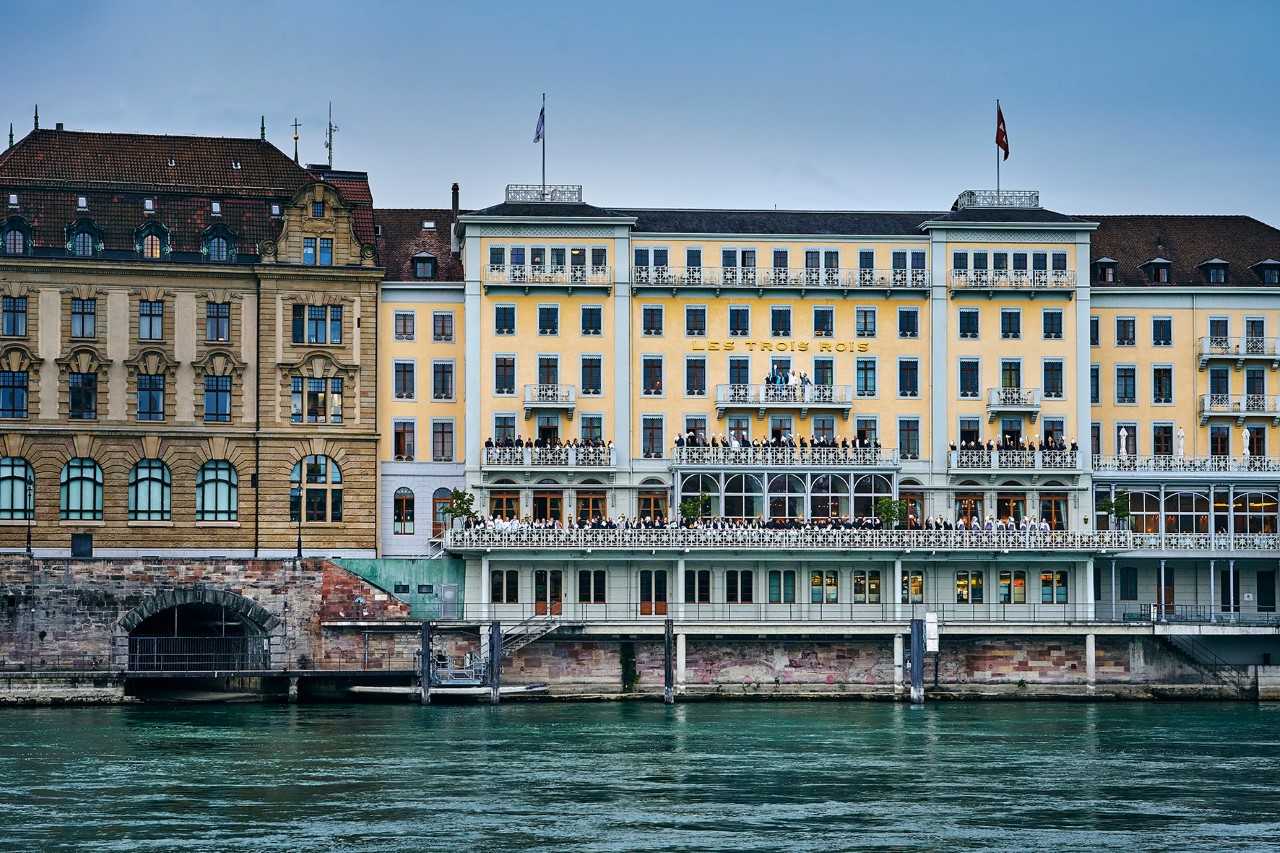
© Grand Hotel Les Trois Rois
4. Letters and diaries
Finding more illustrious visitors to the hotel is like looking for a needle in a haystack or simply a question of coincidence and luck. When Triet et al. published their extensive research on the hotel, there was one famous guest who only just made it into the publication: James Joyce (1882-1941). A letter by James Joyce on the hotel’s branded paper dated 12 August 1937 surfaced in an auction when Alain Moirandat of the Moirandat Company in Basel sold it to a German collector in 2006. James Joyce wrote to the architect Heinrich August Liebetrau (1882-1941) in Rheinfelden, asking him in near-perfect German whether he could recommend a nice and quiet place to stay in Rheinfelden. Joyce spent a couple of weeks in Basel, Rheinfelden and Zürich after having spoken at the 15th PEN congress in Paris (Moirandat).
5. 19th to 21st century: The Golden Book (1844-2004)
The Les Trois Rois also holds an official guest book, the so-called Golden Book. It dates from 1866 but contains cut-out signatures from as early as 1844. The guest book was initially reserved for high nobility, such as the Duchess Victoria of Kent (1786-1861) but later also signed by other personalities (Triet et al. 257; see also 106-07; 130ff; Nagel; Deitmers).
6. Some speculations and dead ends
The search for British and Irish guests at the Les Trois Rois is incomplete and the yield comparatively low. We found several further leads but were not able to confirm at this stage that the visitors to Basel chose the Les Trois Rois, or whether they preferred another place to rest, or simply continued their journey without staying overnight. We discovered, for example, that Meta Gaskell (Elizabeth Gaskell’s daughter) travelled through Switzerland from the 6 May to the 10 August 1860. She had been travelling (or still was) with one of Charles Darwin’s sisters. In a letter to Edward E. Hale on the 14 December 1860, Elizabeth Gaskell recounts Meta’s journey:
“The next family event was Meta’s being invited to go for a tour in S. France & N. Italy by a distant relation, a Miss Darwin, sister of Mr Charles Darwin (‘origin of Species.’) So she set off on the 3rd of May, and two or three days later Marianne followed her (to) / as far as / London” (Chapple and Shelston 218).
A couple of months earlier, Elizabeth Gaskell writes in her letter to Frederic Chapman on the 22 August 1860:
“Where are Mr Lewes & Miss Evans now? My daughter, travelling between Basle & Berne three weeks ago – (about,) fancied they were in the railway carriage with her” (Chapple and Shelston 214).
Perhaps Meta Gaskell was in Basel with Charles Darwin’s sister and stayed at the Les Trois Rois. Regarding George Eliot (Mary Ann Evans) and George Henry Lewes: According to the editors of Gaskell’s letters, Chapple and Shelston, it is possible that Meta Gaskell shared the train with Eliot and Lewes “but not ‘three weeks ago’” as they spent time in Switzerland and stayed in Bern in June 1860 (214n1). George Eliot and George Henry Lewes also stayed in Basel a year earlier, on the 11 July 1859, to visit Lewes’s sons in Zollikofen (Haight 293). Lewes wrote to his sons from Basel, mentioning the “Hotel du Sauwale, Bale” in the letterhead (Baker 287). Could this have meant “Hotel du Sauvage” (Gasthof zum Wilden Mann)?
There are many more visitors who passed through the city on the Dreiländereck; see for instance Joseph Mallord William Turner’s etching (1806-07) of the location where the Les Trois Rois still stands today (!) or Mary Godwin and Percy Bysshe Shelley’s adventure that took them through Mumpf, Rheinfelden and finally Basel in 1814, but whose budget will probably not have provided for a rest in a luxurious bed (Piatti 60-72). Lord Byron’s wealth, on the other hand, secured him a more comfortable journey passed Brussels, along the Rhine through Basel down to Geneva in May 1816 (Marchand 78).
More guests of the Grand Hotel Les Trois Rois
Charles Edward Stuart (1720-1788; in Basel 1754-1756; see SAUTE entry by Stefanie Heeg and Ina Habermann; Triet et al. 50)
John Moore (1729-1802)
Scottish physician and travel writer (Triet et al. 73)
Charles Dickens (1812-1870; in Basel June 1847)
Dickens and Wilkie Collins also describe the hotel in No Thoroughfare (1867) (Triet et al. 149-50)
Anthony Trollope (1815-1882)
We can assume that he stayed at the hotel as he included a description of its balcony in Can You Forgive Her? (1864/65) (Triet et al. 150)
John Ruskin (1819-1900; first time with parents 5 August 1833; Triet et al. 153)
In a letter to Arthur Severn, Ruskin writes: “How I used to love the Trois Rois – the old house – and the sweep of the water under the windows.” (15 July 1881; 370; also qtd. in Triet et al. 171)
Seymour Howard (1886-1967; 6 June 1955; Nagel)
The Lord Mayor of London (1954-1955) who supposedly claimed that the hotel was worthy of accommodating the Queen of England (qtd. in Basler Volksblatt, 13 July 1955)
Field Marshall Montgomery of Alamein (1887-1976; 24 February 1950; 12 August 1956; Triet et al. 119; Nagel)
Harold Malcolm Watts Sargent (1895-1967; February 1959; Nagel)
English conductor
Edward Heath (1916-2005; 23 March 2001; Nagel)
Former Prime Minister of the UK (1970-1974)
Peter Ustinov (1921-2004; 23 November 2000?; Triet et al. 168)
Colin Forbes (1923-2006; Triet et al. 152)
Queen Elizabeth II (1926-2022) and Prince Philip (1921-2021) (May 1980; Nagel)
Visited the Grün 80 (2nd Swiss exhibition on horticulture and landscape gardening)
Elizabeth Taylor (1932-2011; 10-13 June 1991; Triet et al. 158)
Princess Alexandra of Kent (*1936; 22 July 1970; Nagel)
Grandchild of King George V.
Lord David Sainsbury (*1940; in Basel 200?; Nagel)
Politician
Joe Cocker (1944-2014; Triet et al. 147)
Chris de Burgh (*1948; Triet et al. 147)
The Rolling Stones (*1962; in Basel 1995; Triet et al. 147)
Work Cited
Baker, William, editor. The Letters of George Henry Lewes. Vol. I, English Literary Studies, University of Victoria, 1995.
Baumann, Nathalie. “Basel – ‘Das Goldene Tor der Schweiz’.“ Basler Stadtbuch, Christoph Merian Stiftung, 2021, pp. 1-7. https://www.baslerstadtbuch.ch/dossier/2021/2021-04/pdf/Dossier_04_Hotellerie.pdf.pdf?download=true. Accessed 18 October 2022.
Chapple, John and Alan Shelston, editors. Further Letters of Mrs Gaskell. Manchester UP, 2000.
Danziger, Marlies K., editor. James Boswell: The Journal of His German and Swiss Travels. 1764. Edinburgh UP and Yale UP, 2008.
Forbes, John. “The Physician’s Holiday or: A Month in Switzerland in the Summer of 1848.” Wm. S. Orr and Co., 1852. https://www.e-rara.ch/zut/doi/10.3931/e-rara-8396. Accessed 10 October 2022.
Haight, Gordon S. George Eliot: A Biography. Clarendon Press, 1968.
“In doppeltem Sinne: das erste Hotel.” Basler Volksblatt, 13 July 1955. Schweizerisches Wirtschaftsarchiv, https://ub-zas.ub.unibas.ch/en?facets=descr_fuv%7Ehttp%3A%2F%2Fd-nb.info%2Fgnd%2F5087055-5. Accessed 19 October 2022.
Marchand, Leslie A., editor. “So late into the night”: Byron’s Letters and Journals. Vol. 5, 1816-1817, John Murray, 1976.
Moirandat, Alain. Email to Daniela Keller, 12 May 2022.
Nagel, Anne. Email to Daniela Keller, 15 November 2021.
Triet, Maximilian, Anne Nagel and Michael Leuenberger. Les Trois Rois: Einblicke in die Geschichte. Schwabe Verlag, 2006.
Piatti, Barbara. Von Casanova bis Churchill: Berühmte Reisende auf ihrem Weg durch die Schweiz. Hier und Jetzt, 2016.
Stocker, Franz August. Basler Stadtbilder: Alte Häuser und Geschlechter. Basel, 1890.
Storey, Graham, Kathleen Tillotson and Angus Easson, editors. The Letters of Charles Dickens. 1993. Vol. 7, 1853-1855, Clarendon Press, 1996.
Tillotson, Kathleen, editor. The Letters of Charles Dickens. Vol. 4, 1844-1846, Clarendon Press, 1977.
Cook, E.T. and Alexander Wedderburn, editors. “The Letters of John Ruskin, vol. II, 1870-1889.” The Complete Works of John Ruskin, vol. 37, George Allen, 1909.
Acknowledgements
We would like to thank the following people for their help in collecting this information:
Dennis Deitmers, Grand Hotel Les Trois Rois
Thomas Manson, Department of English, University of Basel
Alain Moirandat, Moirandat Company
Anne Nagel, Kantonale Denkmalpflege Basel-Stadt and co-author of Les Trois Rois: Einblicke in die Geschichte

